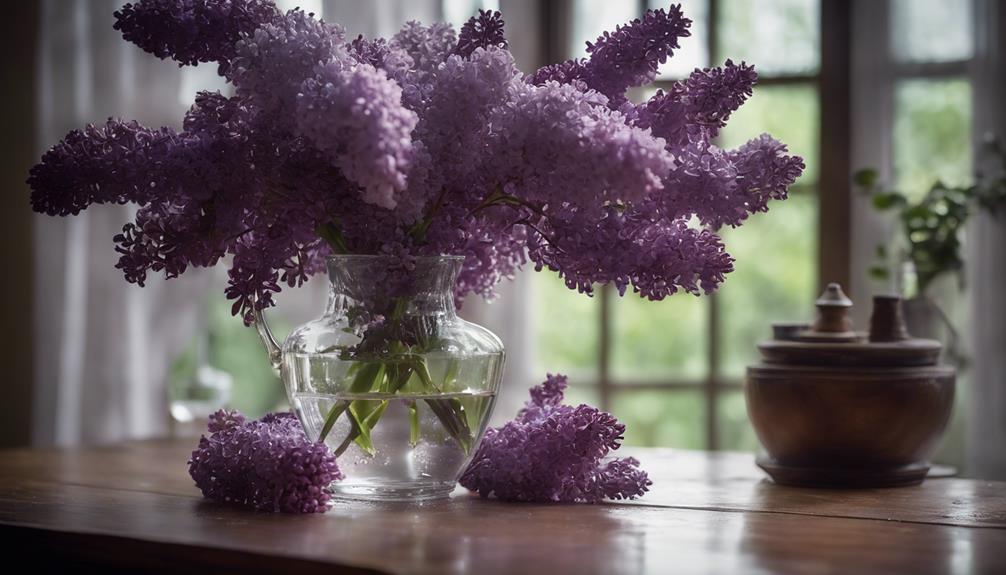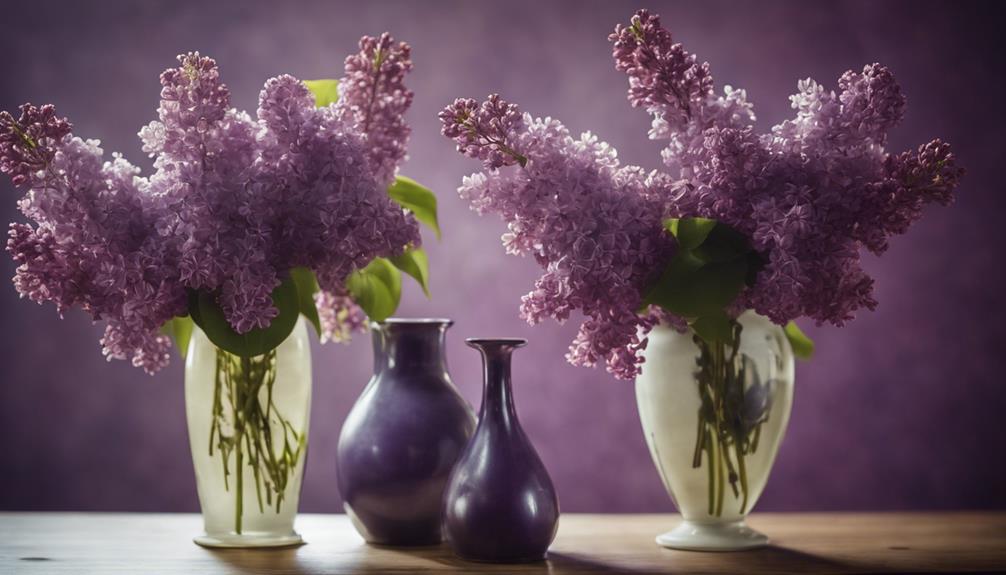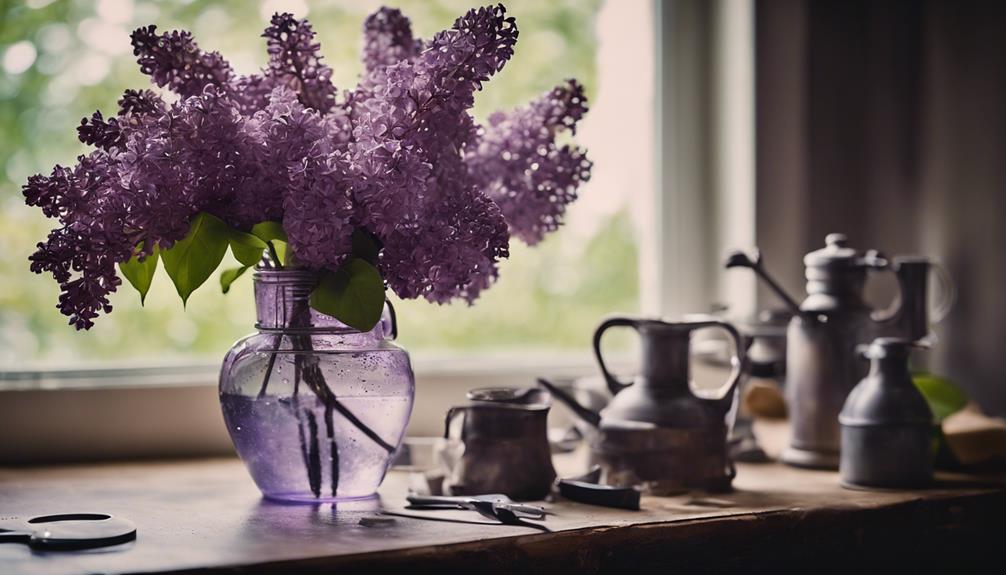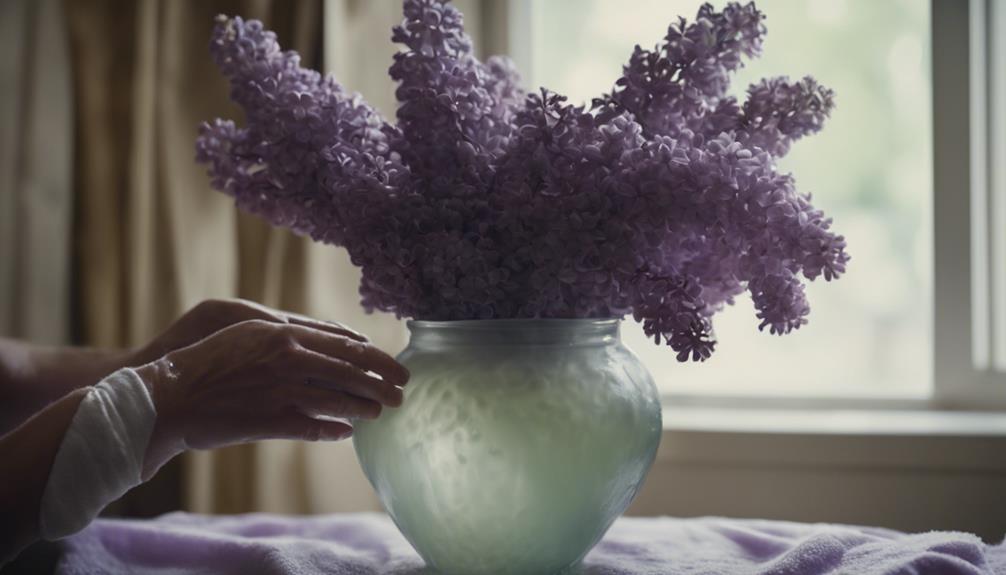To keep lilacs alive in a vase, cut stems at a 45-degree angle and change water every few days. Remove lower leaves and keep stems in clean, lukewarm water. Try using alum for better water absorption, and keep water cool. Don't forget to add floral preservatives to extend their lifespan. Keep the vase clean and change water regularly. If your lilacs start to wilt, trim the stems. These tips can help your lilacs last longer in a vase and remain fresh.
Proper Stem Cutting Techniques
To guarantee the longevity of your cut lilac blooms, start by cutting the stems at a 45-degree angle. This angle allows for better water absorption, ensuring your lilacs stay fresh for an extended period. When cutting the stems, make sure to use sharp, clean scissors to prevent any damage that could inhibit water uptake.
Once you have cut your lilac stems, place them in a vase filled with clean, lukewarm water. Remember to change the water every couple of days to keep it fresh and free from any bacterial buildup. The quality of the water directly impacts the lifespan of your lilac blooms.
Importance of Removing Lower Leaves
When preparing your lilacs for a vase, remember that removing lower leaves is essential. This step guarantees that the water remains clean and free of contamination, preserving the freshness of your blooms.
Lower Leaf Pruning
Removing lower leaves from lilac stems is vital for maintaining the cleanliness of the water and prolonging the vase life of the blooms. By pruning the lower leaves, you guarantee that the water remains uncontaminated and clear, providing a healthier environment for your cut lilacs. This simple step allows the stems to focus on absorbing water efficiently, promoting hydration and extending the lifespan of your beautiful flowers.
Additionally, removing lower leaves helps prevent bacterial growth in the water, preserving the freshness of the lilacs for a longer period. When you trim the lower leaves, you redirect the plant's energy towards nourishing the flowers, enhancing their vibrancy and overall longevity in the vase. Properly trimmed stems without lower leaves contribute to a cleaner and healthier environment for your cut lilacs, ensuring that they maintain their beauty for an extended time.
Water Quality Check
Lower leaf pruning plays a significant role in maintaining the water quality for your cut lilacs, ensuring a clean environment that promotes their longevity in a vase. By removing the lower leaves from the stems, you prevent water contamination and bacterial growth.
When lower leaves are left on the stems, they can decay in the water, leading to a shorter lifespan for your lilac blooms. Keeping the lower part of the stem clean is essential as it allows the lilacs to absorb water more efficiently, keeping them fresh for a longer period.
Water quality is important for the well-being of the cut lilacs in your vase. Ensuring that no leaves are submerged in the water is key to preventing harmful bacteria from developing, which could negatively impact the lilacs' longevity.
Daily Water Change Routine

Maintaining a daily water change routine is essential for preserving the freshness and vitality of lilacs in a vase. Here's why this practice is important:
- Keep Bacteria at Bay: Regular water changes help prevent bacterial growth, keeping the lilac stems healthy and vibrant.
- Extend Vase Life: By changing the water daily, you guarantee the blooms remain hydrated, helping to extend their vase life.
- Nourish Lilac Stems: Fresh water provides essential nutrients to the lilac stems, maintaining their freshness and appearance.
- Enhance Overall Beauty: Removing any wilted or decaying flowers during water changes can help prolong the overall arrangement's beauty.
Benefits of Using Alum
You may be wondering about the benefits of using alum to keep your lilacs fresh in a vase.
Alum can help your lilacs bloom for a longer period, ensuring you enjoy their beauty for days on end.
Additionally, using alum promotes water absorption in the stems, preventing wilting and maintaining the fragrance of your flowers.
Alum for Longer Blooms
Using alum on lilac stems can greatly extend the freshness of the blooms in a vase.
Here's why alum treatment is beneficial for longer-lasting lilac arrangements:
- Enhanced Water Absorption: Alum helps lilac stems, especially woody ones, to absorb water more efficiently, keeping the blooms hydrated and vibrant.
- Extended Vase Life: By applying alum before placing lilacs in water, you can potentially double the lifespan of the blooms, allowing you to enjoy them for a more extended period.
- Prevents Drying Out: Alum treatment prevents the stems from sealing, ensuring that the lilacs don't dry out quickly, maintaining their freshness and fragrance.
- Comparative Freshness: Fresh-cut lilacs without alum treatment may start wilting within a day or two, underscoring the effectiveness of alum in preserving the blooms' freshness.
Alum and Water Absorption
Furthermore, utilizing alum for ideal water absorption in lilac stems can greatly enhance the longevity of the blooms in a vase.
Alum acts as a beneficial agent for cut flowers with woody stems like lilacs. When you add alum to the water in the vase, it helps the lilac stems drink water more efficiently, keeping the flowers fresh for a longer period.
By applying alum before placing the lilacs in water, you prevent the stems from sealing and drying out, ensuring they can continue to absorb water effectively. This treatment with alum has been shown to double the lifespan of cut lilacs, maintaining their vibrancy and fragrance.
Additionally, using alum on lilacs and other flowers with woody stems, such as hydrangeas and roses, can provide similar benefits, enhancing the overall appeal and beauty of the floral arrangement.
Alum to Prevent Wilting
The application of alum effectively prevents wilting in cut lilacs, ensuring their longevity in a vase. When using alum to treat cut stems, you can benefit from:
- Enhanced Water Absorption: Alum treatment helps cut lilac stems drink water efficiently, keeping them fresh for a longer period.
- Prevent Wilting: By dipping the stems in alum before placing them in water, you can prevent wilting and maintain the blooms' vibrancy.
- Extended Lifespan: Changing the water daily and reapplying alum can double the lifespan of cut lilacs in a vase.
- Continuous Hydration: Alum prevents stems from sealing, allowing for continuous water absorption and hydration, which is essential for flower freshness.
The effectiveness of alum treatment is evident in extending the freshness and fragrance of lilacs, making them a beautiful and long-lasting addition to your home decor.
Impact of Stem Length

To maximize the longevity of lilacs in a vase, consider the impact of stem length on their freshness and vibrancy. Longer stems provide more access to water in your vase, helping the flowers stay hydrated and vibrant.
When cutting the stems, be sure to trim them at a 45-degree angle. This angle allows for better water absorption, ensuring the blooms receive an essential water supply to thrive.
The length of the stems plays a vital role in how long lilacs can last in a vase, with longer stems generally resulting in an extended vase life. Maintaining the appropriate stem length is important for sustaining the lilacs' vibrancy and fragrance.
Maintaining Cool Water Temperature
Maintain peak freshness and longevity of lilacs in a vase by keeping the water temperature cool, ideally around 40-50°F.
Here are some key tips to help you achieve this:
- Use Cold Water: Cold water is essential to slow down the aging process of cut lilacs and maintain their freshness.
- Avoid Warm Water: Warm water can accelerate the deterioration of lilacs, so make sure to check and adjust the water temperature regularly.
- Choose a Cool Location: Placing the vase in a cool spot away from direct sunlight can help preserve the water temperature and keep the lilacs looking vibrant.
- Change Water Daily: Enhance the longevity of your cut lilacs by changing the water every day with fresh, cool water. This simple step can greatly improve the lifespan of your lilac arrangement.
The Role of Floral Preservatives

Consider incorporating a floral preservative when arranging lilacs in a vase to extend their lifespan and maintain their vibrancy. Floral preservatives play an important role in providing essential nutrients to cut flowers like lilacs.
These solutions contain ingredients such as citric acid, sugar, and bleach, which nourish the flowers and help prevent bacterial growth. By maintaining clean water and promoting water uptake in the cut stems, floral preservatives can greatly prolong the life of lilacs in a vase.
The solution also helps in maintaining the pH levels, which further enhances the flowers' ability to absorb water and nutrients. Using a properly mixed floral preservative can't only increase the longevity of lilacs but also enhance their freshness, color, and fragrance.
Significance of Regular Stem Trimming
Consistently trimming lilac stems guarantees the best water absorption and freshness of the blooms. When it comes to caring for your lilac flowers in a vase, regular stem trimming plays an important role in maintaining their vitality and beauty. Here's why it matters:
- Enhanced Water Absorption:
Trimming the stems at a 45-degree angle boosts water uptake, keeping your lilacs hydrated and vibrant.
- Prolonged Vase Life:
By preventing blockages and decay, frequent stem trimming ensures a longer lifespan for your cut lilacs.
- Improved Hydration:
Cutting the stems at an angle creates more surface area for water intake, promoting the overall health of the flowers.
- Longer Lasting Blooms:
Continuous stem trimming eliminates any deteriorating parts, contributing to the longevity of your lilacs in the vase.
Ensuring Vase Hygiene

To guarantee the longevity and freshness of your cut lilacs in the vase, prioritize maintaining proper hygiene measures.
Start by cleaning the vase thoroughly using hot water, dish soap, and vinegar to prevent bacterial growth and contamination of the water.
Adding a floral preservative or crushed aspirin to the water will provide essential nutrients and help the lilacs stay fresh longer.
Make sure the vase is residue-free and completely dry before refilling it with water to keep the lilacs clean and vibrant.
Remember to change the water every couple of days to avoid bacteria buildup and to keep the lilacs hydrated.
Additionally, if you notice any wilting, re-trim the stems of the lilacs to encourage water absorption and maintain the freshness of the blooms in the vase.
Conclusion
So, now you know the secrets to keeping your lilacs alive in a vase! By following these steps and tips, you can enjoy the beauty and fragrance of fresh lilacs for longer periods of time.
Remember, proper stem cutting techniques, daily water changes, and using alum can make a big difference in the lifespan of your flowers. Give it a try and see for yourself the difference it makes!